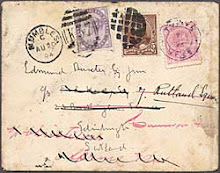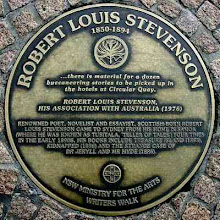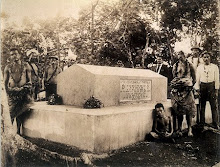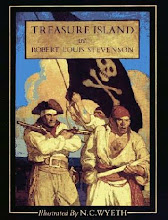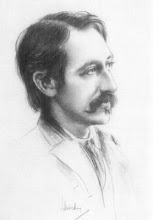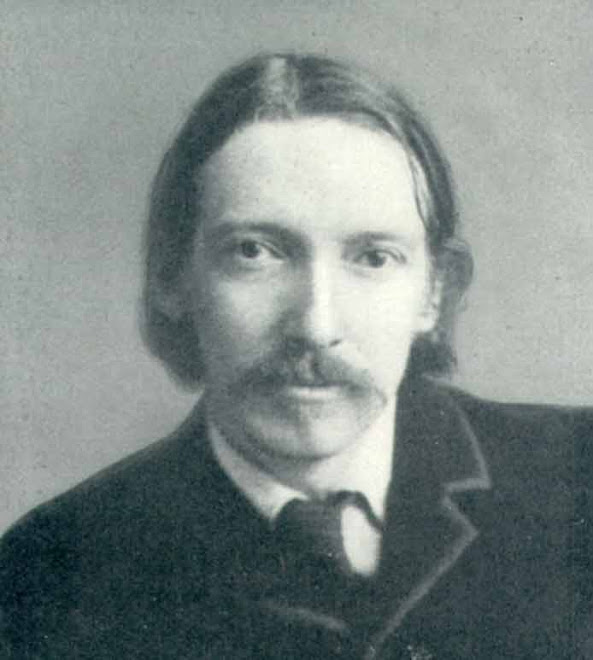Robert Louis Balfour Stevenson (13 November 1850–3 December 1894), was a Scottish novelist, poet, essayist and trvel writer. He was the man who "seemed to pick the right word up on the point of his pen, like a man playing spillikins", as G.K. Chesterton put it. Stevenson was greatly admired by many authors, including Jorge Luis Borges,Ernest Hemingway,Rudyard Kipling,Vladimir Nabokov, and J.M.Barrie..
Stevenson was born Robert Lewis Balfour Stevenson at 8 Howard Place,Edinburgh, Scotland, on 13 November 1850, to Thomas Stevenson (1818-1887), a leading lighthouse engineer, and his wife Margaret, born Margaret Isabella Balfour (1829-1897). Lighthouse design was the family profession: Thomas's own father was the famous Robert Stevenson, and his maternal grandfather, Thomas Smith, and brothers Alan and David were also among those in the business. On Margaret's side, the family were gentry, tracing their name back to an Alexander Balfour, who held the lands of Inchrye in Fife in the fifteenth century. Her father, Lewis Balfour (1777-1860), was a minister of the Church of Scotland at nearby Colinton, and Stevenson spent the greater part of his boyhood holidays in his house. "Now I often wonder", says Stevenson, "what I inherited from this old minister. I must suppose, indeed, that he was fond of preaching sermons, and so am I, though I never heard it maintained that either of us loved to hear them."
Both Balfour and his daughter had a "weak chest" and often need to stay in warmer climates for their health. Stevenson inherited a tendency to coughs and fevers, exacerbated when the family moved to a damp and chilly house at 1 Inverleith Terrace in 1853. The family moved again to the sunnier 17 Heriot Row when Stevenson was six, but the tendency to extreme sickness in winter remained with him until he was eleven. Illness would be a recurrent feature of his adult life, and left him extraordinarily thin. Contemporary views were that he had tuberculosis, but more recent views are that it was bronchiectasis or even sarcoidosis.
Stevenson's parents were both devout and serious presbyterians, but the household was not unusually strict. His nurse, Alison Cunningham (known as Cummy), was more fervently religious. Her Calvinism and folk beliefs were an early source of nightmares for the child; and he showed a precocious concern for religion. But she also cared for him tenderly in illness, reading to him as he lay sick in bed from Bunyan and the bible, and telling tales of the Covenanters. Stevenson recalled this time of sickness in the poem "The Land of Counterpane" inA Child’s Garden of Verses and dedicated the book to his nurse.
At eleven his parents sent him to Edinburgh Academy, planning for him to follow his father as a lighthouse engineer. During this period he read widely and especially enjoyed Shakespeare,Walter Scott,John Bunyan and The Arabian Nights.
He entered the University of Edinburgh at 17, but soon discovered he had neither the scientific mind nor physical endurance to succeed as an engineer. When his father took him for a voyage he found—instead of being interested in lighthouse construction—that his mind was teeming with wonderful romances about the coast and islands which they visited. In 1871, he announced to his father his decision to pursue a life of letters. Though the elder Stevenson was naturally disappointed, Stevenson's mother eventually reported that he was "wonderfully resigned" to his son's choice. Wisely, young Robert decided he should take a law degree at the University of Edinburgh so that he would have a career to fall back on if he were not able to support himself financially through the sale of novels. In a poem he later wrote for Underwood's Magazine, he commented on his family's response to his decision, writing:
Say not of me that weakly I declinedThe labours of my sires, and fled the sea,The towers we founded and the lamps we lit,But rather say: In the afternoon of timeA strenuous family dusted from its handsThe sand of granite, and beholding farAlong the sounding coast its pyramidsAnd tall memorials catch the dying sun,Smiled well content, and to this childish taskAround the fire addressed its evening hours.The next four years were spent mostly in travel and in search of a climate that would be more beneficial for his health. He made long and frequent trips to Fontainebleau, Barbizon, Grez, and Nemours, becoming a member of the artists' colonies there, as well as to Paris to visit galleries and the theatres. It was during this period he made most of his lasting friendships and met his future wife, Fanny Vandegrift Osbourne, an American who was 10 years his senior and married at the time. Among his friends were Sidney Colvin, his biographer and literary agent;William Ernest Henley, a collaborator in dramatic composition; Mrs. Sitwell, who helped him through a religious crisis; and Andrew Lang, Edmund Gosse, and Leslie Stephen, all writers and critics. He also made the journeys described in An Inland Voyage and Travels with a Donkeyin the Cevennes. In addition, he wrote 20 or more articles and essays for various magazines. Although it seemed to his parents that he was wasting his time and being idle, in reality he was constantly studying to perfect his style of writing and broaden his knowledge of life, emerging as a man of letters.
Stevenson and Fanny Vandegrift Osbourne met in France in 1876. A few months later, when she returned to her home in San Francisco,California, , Stevenson determined to follow. His friends advised against the journey, knowing his father's temper, but he sailed without notifying his parents. He took steerage passage on the Devonian, in part to save money, but also to learn how others travelled and to increase the adventure of the journey. From New York City he travelled overland by train to California. He later wrote about the experience in An Amateur Emigrant and Across the Plains. Although it was good experience for his literature, it broke his health, and he was near death when he arrived in Monterey. He was nursed back to health by some ranchers there.
By December of 1879 he had recovered his health enough to continue to San Francisco, where for several months he struggled "all alone on forty-five cents a day, and sometimes less, with quantities of hard work and many heavy thoughts," in an effort to support himself through his writing, but by the end of the winter his health was broken again, and he found himself at death's door. Vandegrift — now divorced and recovered from her own illness — came to Stevenson's bedside and nursed him to recovery. "After a while," he wrote, "my spirit got up again in a divine frenzy, and has since kicked and spurred my vile body forward with great emphasis and success." When his father heard of his condition he cabled him money to help him through this period.
In May, 1880, Stevenson married Fanny although, as he said, he was "a mere complication of cough and bones, much fitter for an emblem of mortality than a bridegroom." With his new wife and her son, Lloyd, he travelled north of San Francisco toBapa Valley, and spent a summer honeymoon at an abandoned mining camp on Mount Saint Helena. He wrote about this experience in The Silverado Squatters. He met Charles Warren Stoddard, co-editor of the Overland Monthly and author of South Sea Idylls, who urged Stevenson to travel to the south Pacific, an idea which would return to him many years later. In August 1880 he sailed with his family from New York back to Britain, and found his parents and his friend Sidney Colvin on the wharf at Liverpool, happy to see him return home. Gradually his new wife was able to patch up differences between father and son and make herself a part of the new family through her charm and wit.
For the next seven years between 1880 and 1887 Stevenson searched in vain for a place of residence suitable to his state of health. He spent his summers at various places in Scotland and England, including Westbourne,Dorset, a residential area in Bournemouth. There he lived in a dwelling he renamed Skerryvore after a lighthouse, the tallest in Scotland, built by his uncle Alan Stevenson many years earlier. For his winters, he escaped to sunny France, and lived at Davos-Platz and the Chalet de Solitude at Hyeres, where, for a time, he enjoyed almost complete happiness. "I have so many things to make life sweet for me," he wrote, "it seems a pity I cannot have that other one thing — health. But though you will be angry to hear it, I believe, for myself at least, what is is best. I believed it all through my worst days, and I am not ashamed to profess it now." In spite of his ill health he produced the bulk of his best known work: Treasure Island, his first widely popular book; Kidnapped: The Strange Case of Dr.Jekyl and Mr.Hyde, the story which established his wider reputation; and two volumes of verse, A Child’s Garden of Verses and Underwoods. At Skerryvore he gave a copy of Kidnapped to his dear friend and frequent visitor,Henry James..
On the death of his father in 1887, Stevenson felt free to follow the advice of his physician to try a complete change of climate. He started with his mother and family for Colorado; but after landing in New York they decided to spend the winter at Saranac Lake, in the Adirondacks. During the intensely cold winter Stevenson wrote a number of his best essays, including Pulvis et Umbra, he began The Master of Ballantrae, and lightheartedly planned, for the following summer, a cruise to the southern Pacific Ocean. "The proudest moments of my life," he wrote, "have been passed in the stern-sheets of a boat with that romantic garment over my shoulders."
In June 1888, Stevenson chartered the yacht Casco and set sail with his family from San Francisco. The vessel "plowed her path of snow across the empty deep, far from all track of commerce, far from any hand of help." The salt sea air and thrill of adventure for a time restored his health; and for nearly three years he wandered the eastern and central Pacific, visiting important island groups, stopping for extended stays at the Hawaiian Islands where he became a good friend of King David Kalakaua, with whom Stevenson spent much time. Furthermore, Stevenson befriended the king's niece Princess Victoria Kaiulani, who was of Scottish heritage. He also spent time at the Gilbert Islands,Tahiti and the Samoan Islands. During this period he completed The Master of Ballantrae, composed two ballads based on the legends of the islanders, and wrote The Bottle Imp. The experience of these years is preserved in his various letters and in The South Seas. A second voyage on the Equator followed in 1889 with Lloyd Osbourne accompanying them.
It was also from this period that one particular open letter stands as testimony to his activism and indignation at the pettiness of such 'powers that be' as a Presbyterian minister in Honolulu named Rev. Dr. Hyde. During his time in the Hawaiian Islands, Stevenson had visited Molokai and the leper colony there, shortly after the demise of Father Damien. When Dr. Hyde wrote a letter to a fellow clergyman speaking ill of Father Damien, Stevenson wrote a scathing open letter of rebuke to Dr. Hyde. Soon afterwards in April 1890 Stevenson left Sydney on the Janet Nicoll and went on his third and final voyage among the South Seas islands.
In 1890 he purchased four hundred acres (about 1.6 square kilometres) of land in Upolu, one of the Samoan islands. Here, after two aborted attempts to visit Scotland, he established himself, after much work, upon his estate, which he named Vailima ("Five Rivers"). Stevenson himself adopted the native name Tusitala. His influence spread to the natives who consulted him for advice, and he soon became involved in local politics. He was convinced the European officials appointed to rule the natives were incompetent, and after many futile attempts to resolve the matter, he published A Footnote to History. This was such a stinging protest against existing conditions that it resulted in the recall of two officials, and Stevenson feared for a time it would result in his own deportation. When things had finally blown over he wrote a friend, "I used to think meanly of the plumber; but how he shines beside the politician!"
In addition to building his house and clearing his land and helping the natives in many ways, he found time to work at his writing. In his enthusiasm, he felt that "there was never any man had so many irons in the fire." He wrote The Beach of Falesa,Catriona (titled David Balfour in the USA), The Ebb-Tide, and the Vailima Letters, during this period.
For a time during 1894 Stevenson felt depressed; he wondered if he had exhausted his creative vein and completely worked himself out. He wrote that he had "overworked bitterly". He felt more clearly that, with each fresh attempt, the best he could write was "ditch-water". He even feared that he might again become a helpless invalid. He rebelled against this idea: "I wish to die in my boots; no more Land of Counterpane for me. To be drowned, to be shot, to be thrown from a horse — ay, to be hanged, rather than pass again through that slow dissolution." He then suddenly had a return of his old energy and he began work on Weir of Hermiston. "It's so good that it frightens me," he is reported to have exclaimed. He felt that this was the best work he had done. He was convinced, "sick and well, I have had splendid life of it, grudge nothing, regret very little ... take it all over, damnation and all, would hardly change with any man of my time."
Without knowing it, he was to have his wish fulfilled. During the morning of 3 December 1894, he had worked hard as usual on Weir of Hermiston. During the evening, while conversing with his wife and straining to open a bottle of wine, he suddenly exclaimed, "What's that!" He then asked his wife, "Does my face look strange?" and collapsed beside her. He died within a few hours, probably of a cerebral haemorrhage, at the age of 44. The natives insisted on surrounding his body with a watch-guard during the night, and on bearing their Tusitala ( Samoan for "Story Writer") upon their shoulders to nearby Mt Vaea and buried him on a spot overlooking the sea. A tablet was placed there, which bore the inscription of his 'Requiem', the piece he always had intended as his epitaph:
“ Under the wide and starry sky,
Dig the grave and let me lie.
Glad did I live and gladly die,
And I laid me down with a will.
This be the verse you grave for me:
Here he lies where he longed to be;
Home is the sailor,
home from sea,
And the hunter home from the hill. ”
Stevenson was a celebrity in his own time, but with the rise of modern literature after World War I, he was seen for much of the 20th century as a writer of the second class, relegated to children’s literature and horror genres. Condemned by authors such as Virginia and Leonard Woolf, he was gradually excluded from the canon of literature taught in schools. His exclusion reached a height when in the 1973 2,000-pageOxford Anthology of English Literature Stevenson was entirely unmentioned; and the Norton Anthology of English Literature excluded him from 1968 to 2000 (1st–7th editions), including him only in the 8th edition (2006). The late 20th century saw the start of a re-evaluation of Stevenson as an artist of great range and insight, a literary theorist, an essayist and social critic, a witness to the colonial history of the Pacific Islands, and a humanist. Even as early as 1965 the pendulum had begun to swing: he was praised by Roger Lancelyn Green, one of the Oxford Inklings, as a writer of a consistently high level of "literary skill or sheer imaginative power" and a co-originator with H.Rider Haggard of the Age of the Story Tellers. He is now being re-evaluated as a peer of authors such as Joseph Conrad (whom Stevenson influenced with his South Seas fiction) and Henry James, with new scholarly studies and organizations devoted to Stevenson.No matter what the scholarly reception, Stevenson remains very popular around the world. According to the Index Translationum, Stevenson is ranked the 25th most translated author in the world, ahead of fellow nineteenth-century writers Charles Dickens,Oscar Wilde and Edgar Allan Poe.
Treasure Island (1883) His first major success, a tale of piracy, buried treasure, and adventure, has been filmed frequently. He originally entitled it The Sea Cook but an editor changed it.
The Black Arrow: A Tale of the Two Roses (1883) An historical adventure novel and romance set during the Wars of the Roses. This novel presents the Wars of the Roses, as it were, in miniature.
Prince Otto (1885) Stevenson’s third full-length narrative, an action romance set in the imaginary Germanic state of Grünewald.
Strange Case of Dr Jekyl and Mr Hyde (1886), a novella about a dual personality much depicted in plays and films, also influential in the growth of understanding of the subconscious mind through its treatment of a kind and intelligent physician who turns into a psychopathic monster after imbibing a drug intended to separate good from evil in a personality.
Kidnapped (1886) is a historical novel that tells of the boy David Balfour's pursuit of his inheritance and his alliance with Alan Breck in the intrigues of Jacobite troubles in Scotland.
The Master of Ballantrae (1889), a masterful tale of revenge, set in Scotland, America, and India.
The Wrong Box (1889); co-written with Lloyd Osbourne. A comic novel of a tontine, also filmed (1966). A tontine is a group life-insurance policy in which all the benefits go to the last survivor. Both in the novel and in real life, it is an incentive to murder, and no longer legal in most countries.
The Wrecker (1892); co-written with Lloyd Osbourne.
Catriona (1893), also known as David Balfour, is a sequel to Kidnapped, telling of Balfour's further adventures.
The Ebb-Tide (1894); co-written with Lloyd Osbourne.
Weir of Hermiston (1896). Unfinished at the time of Stevenson's death, considered to have promised great artistic growth.
St.Ives : being the Adventures of a French Prisoner in England (1897). Unfinished at the time of Stevenson's death, the novel was completed by Arthur Quiller-Couch..
Short story collections
New Arabian Nights (1882)
More New Arabian Nights:The Dynamiter (1885); co-written with Fanny Van De Grift Stevenson.
The Merry Men and Other Tales and Fables (1887)
Island Night’ Entertainments (also known as South Sea Tales) (1893)
Monday 13 October 2008
Subscribe to:
Posts (Atom)
